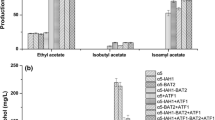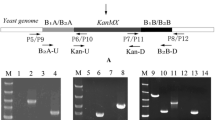Abstract
Acetate esters and higher alcohols significantly determine the flavor profiles of Chinese Baijiu (Chinese liquor). The aminotransferase encoded by BAT2 and alcohol acetyltransferases encoded by ATF1, ATF2, and Lg-ATF1 are involved in the production of branched-chain alcohols and synthesis of acetate esters, respectively. In this study, the effects of ATF1, ATF2, and Lg-ATF1 overexpressions with BAT2 deletion were explored in Chinese Baijiu yeast. The differences among these effects were also investigated. Results showed that the productions of acetate esters by mutant overexpressing ATF1 with BAT2 deletion and that overexpressing ATF2 with BAT2 deletion were 1353.45 and 73.40 mg/L, respectively, which were 43.16- and 2.34-fold higher than that by the original strain. Compared with mutant overexpressing ATF2 with BAT2 deletion, mutant overexpressing ATF1 with BAT2 deletion exhibited 48.17% decreased higher alcohol productivity. The production of higher alcohols in mutant overexpressing ATF2 with BAT2 deletion was similar to that in the BAT2 deletion mutant. Furthermore, no significant difference was observed between the BAT2 deletion mutant and the mutant overexpressing Lg-ATF1 with BAT2 deletion in terms of acetate ester and higher alcohol production. The mutants that have varying capacities for acetate ester and higher alcohol production can be potentially developed and applied.





Similar content being viewed by others
References
Fan W, Qian MC (2006) Characterization of aroma compounds of Chinese “Wuliangye” and “Jiannanchun” liquors by aroma extract dilution analysis. J Agric Food Chem 54(7):2695–2704. doi:10.1021/jf052635t
Ding X, Wu C, Huang J, Zhou R (2015) Changes in volatile compounds of Chinese Luzhou-flavor liquor during the fermentation and distillation process. J Food Sci 80(11):C2373–C2381. doi:10.1111/1750-3841.13072
Xiao Z, Yu D, Niu Y, Chen F, Song SQ, Zhu JC, Zhu GY (2014) Characterization of aroma compounds of Chinese famous liquors by gas chromatography–mass spectrometry and flash GC electronic-nose. J Chromatogr B s945–946(2):92–100. doi:10.1016/j.jchromb.2013.11.032
Swiegers JH, Pretorius IS (2005) Yeast modulation of wine flavor. Adv Appl Microbiol 57:131–175. doi:10.1016/S0065-2164(05)57005-9
Yang D, Luo X, Wang X (2014) Characteristics of traditional Chinese shanlan wine fermentation. J Biosci Bioeng 117(2):203–207. doi:10.1016/j.jbiosc.2013.07.010
Lilly M, Bauer FF, Lambrechts MG, Swiegers JH, Cozzolino D, Pretorius IS (2006) The effect of increased yeast alcohol acetyltransferase and esterase activity on the flavour profiles of wine and distillates. Yeast 23(9):641–659. doi:10.1002/yea.1382
Wu Q, Yu K, Yan X (2015) Flavor profile of Chinese liquor is altered by interactions of intrinsic and extrinsic microbes. Appl Environ Microbiol 82(2):422–430. doi:10.1128/AEM.02518-15
Fan W, Qian MC (2005) Headspace solid phase microextraction and gas chromatography–olfactometry dilution analysis of young and aged Chinese “Yanghe Daqu” liquors. J Agric Food Chem 53(20):7931–7938. doi:10.1021/jf051011k
Wu XH, Zheng XW, Han BZ, Vervoort J, Nout MJ (2009) Characterization of Chinese liquor starter, “Daqu”, by flavor type with 1H NMR-based nontargeted analysis. J Agric Food Chem 57(23):11354–11359. doi:10.1021/jf902881p
Zhang C, Ao Z, Chui W, Shen C, Tao W, Zhang S (2012) Characterization of the aroma-active compounds in Daqu: a tradition Chinese liquor starter. Eur Food Res Technol 234(1):69–76. doi:10.1007/s00217-011-1616-4
Nordström K (1962) Formation of ethyl acetate in fermentation with brewer’s yeast III. Participation of coenzyme A. J Inst Brew 68:398–407. doi:10.1002/j.2050-0416.1962.tb01882.x
Nagasawa N, Bogaki T, Iwamatsu A, Hamachi M, Kumagai C (1998) Cloning and nucleotide sequence of the alcohol acetyltransferase II gene (ATF2) from Saccharomyces cerevisiae Kyokai No. 7. Biosci Biotechnol Biochem 62(10):1852–1857. doi:10.1271/bbb.62.1852
Yoshimoto H, Fujiwara D, Momma T, Ito C, Sone H, Kaneko Y, Tamai Y (1998) Characterization of the ATF1 and Lg-ATF1 genes encoding alcohol acetyltransferases in the bottom fermenting yeast Saccharomyces pastorianus. J Ferment Bioeng 86(1):15–20. doi:10.1016/S0922-338X(98)80027-5
Verstrepen KJ, Laere SDMV, Vanderhaegen BMP, Derdelinckx G, Dufour JP, Pretorius IS, Winderickx J, Thevelein JM, Delvaux FR (2003) Expression levels of the yeast alcohol acetyltransferase genes ATF1, Lg-ATF1, and ATF2 control the formation of a broad range of volatile esters. Appl Environ Microbiol 69(9):5228–5237. doi:10.1128/AEM.69.9.5228-5237.2003
Molina AM, Swiegers JH, Varela C, Pretorius IS, Agosin E (2007) Influence of wine fermentation temperature on the synthesis of yeast-derived volatile aroma compounds. Appl Microbiol Biotechnol 77(3):675–687. doi:10.1007/s00253-007-1194-3
Dekoninck TML, Verbelen PJ, Delvaux F, Mulders SEV, Delvaux FR (2012) The importance of wort composition for yeast metabolism during accelerated brewery fermentations. J Am Soc Brew Chem 70(3):195–204. doi:10.1016/j.cervis.2013.09.026
Procopio S, Qian F, Becker T (2011) Function and regulation of yeast genes involved in higher alcohol and ester metabolism during beverage fermentation. Eur Food Res Technol 233(5):721–729. doi:10.1007/s00217-011-1567-9
Fujii T, Yoshimoto H, Tamai Y (1996) Acetate ester production by Saccharomyces cerevisiae lacking the ATF1 gene encoding the alcohol acetyltransferase. J Ferment Bioeng 81(6):538–542. doi:10.1016/0922-338X(96)81476-0
Lilly M, Lambrechts MG, Pretorius IS (2000) Effect of increased yeast alcohol acetyltransferase activity on flavor profiles of wine and distillates. Appl Environ Microbiol 66(2):744–753. doi:10.1128/AEM.66.2.744-753.2000
Hirosawa I, Aritomi K, Hoshida H, Kashiwagi S, Nishizawa Y, Akada R (2004) Construction of a self-cloning sake yeast that overexpresses alcohol acetyltransferase gene by a two-step gene replacement protocol. Appl Microbiol Biotechnol 65(1):68–73. doi:10.1007/s00253-004-1563-0
Zhang JW, Zhang CY, Dai LH, Dong J, Liu YL, Guo XW, Xiao DG (2012) Effects of overexpression of the alcohol acetyltransferase-encoding gene ATF1 and disruption of the esterase-encoding gene IAH1 on the flavour profiles of Chinese yellow rice wine. Int J Food Sci Technol 47(12):2590–2596. doi:10.1111/j.1365-2621.2012.03140.x
Zhang CY, Liu YL, Qi YN, Zhang JW, Dai LH, Lin X, Xiao DG (2013) Increased esters and decreased higher alcohols production by engineered brewer’s yeast strains. Eur Food Res Technol 236(6):1009–1014. doi:10.1007/s00217-013-1966-1
Zhang J, Zhang C, Qi Y, Dai L, Ma H, Guo X, Xiao D (2014) Acetate ester production by Chinese yellow rice wine yeast overexpressing the alcohol acetyltransferase-encoding gene ATF2. Genet Mol Res 13(4):9735–9746. doi:10.4238/2014.November.27.1
Zhang J, Zhang C, Wang J, Dai L, Xiao D (2014) Expression of the gene Lg-ATF1 encoding alcohol acetyltransferases from brewery lager yeast in Chinese rice wine yeast. Lect Notes Electr Eng 249:43–51. doi:10.1007/978-3-642-37916-1-5
Li W, Wang JH, Zhang CY, Ma HX, Xiao DG (2017) Regulation of Saccharomyces cerevisiae genetic engineering on the production of acetate esters and higher alcohols during Chinese Baijiu fermentation. J Ind Microbiol Biotechnol. doi:10.1007/s10295-017-1907-2
Dickinson JR, Norte V (1993) A study of branched-chain amino acid aminotransferase and isolation of mutations affecting the catabolism of branched-chain amino acids in Saccharomyces cerevisiae. FEBS Lett 326(1–3):29–32. doi:10.1016/0014-5793(93)81754-N
Derrick S, Large PJ (1993) Activities of the enzymes of the Ehrlich pathway and formation of branched-chain alcohols in Saccharomyces cerevisiae and Candida utilis grown in continuous culture on valine or ammonium as sole nitrogen source. J Gen Microbiol 139(11):2783–2792. doi:10.1099/00221287-139-11-2783
Eden A, Nedervelde LV, Drukker M, Benvenisty N, Debourg A (2001) Involvement of branched-chain amino acid aminotransferases in the production of fusel alcohols during fermentation in yeast. Appl Microbiol Biotechnol 55(3):296–300. doi:10.1007/s002530000506
Dickinson JR, Salgado LEJ, Hewlins MJE (2003) The catabolism of amino acids to long chain and complex alcohols in Saccharomyces cerevisiae. J Biol Chem 278:8028–8034. doi:10.1074/jbc.M211914200
Lilly M, Bauer FF, Styger G, Lambrechts MG, Pretorius IS (2006) The effect of increased branched-chain amino acid transaminase activity in yeast on the production of higher alcohols and on the flavour profiles of wine and distillates. FEMS Yeast Res 6(5):726–743. doi:10.1111/j.1567-1364.2006.00057.x
Zhang CY, Qi YN, Ma HX, Li W, Dai LH, Xiao DG (2015) Decreased production of higher alcohols by Saccharomyces cerevisiae for Chinese rice wine fermentation by deletion of bat aminotransferases. J Ind Microbiol Biotechnol 42(4):617–625. doi:10.1007/s10295-015-1583-z
Gietz RD, Woods RA (2002) Transformation of yeast by lithium acetate/single-stranded carrier DNA/polyethylene glycol method. Methods Enzymol 350:87–96. doi:10.1016/S0076-6879(02)50957-5
Gueldener U, Heinisch J, Koehler GJ, Voss D, Hegemann JH (2002) A second set of loxP marker cassettes for Cre-mediated multiple gene knockouts in budding yeast. Nucleic Acids Res 30(6):e23
Acknowledgements
This work was supported by the National Key Research and Development Program of China (2016YFD0400505), the National Natural Science Foundation of China (31471724), the Major Project of Research Program on Applied Fundamentals and Advanced Technologies of Tianjin (14JCZDJC32900), and the National High Technology Research and Development Program of China (2013AA102108).
Author information
Authors and Affiliations
Corresponding authors
Ethics declarations
Conflict of interest
The authors declare that they have no conflict of interest.
Compliance with ethics requirements
This article does not contain any studies with human or animal subjects.
Rights and permissions
About this article
Cite this article
Li, W., Cui, DY., Wang, JH. et al. Overexpression of different alcohol acetyltransferase genes with BAT2 deletion in Saccharomyces cerevisiae affects acetate esters and higher alcohols. Eur Food Res Technol 244, 555–564 (2018). https://doi.org/10.1007/s00217-017-2977-0
Received:
Revised:
Accepted:
Published:
Issue Date:
DOI: https://doi.org/10.1007/s00217-017-2977-0




